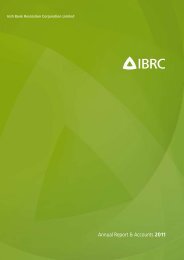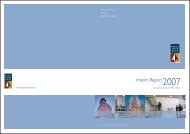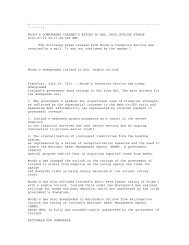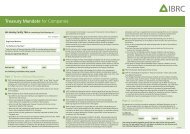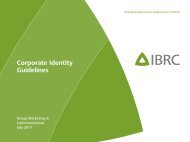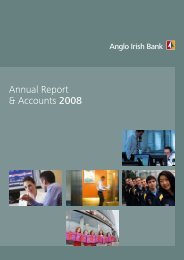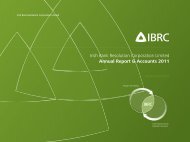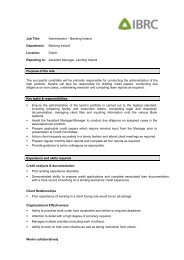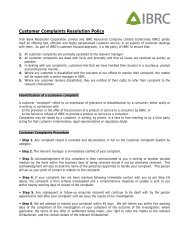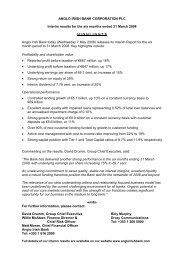Annual Report & Accounts 2009 - Anglo Irish Bank
Annual Report & Accounts 2009 - Anglo Irish Bank
Annual Report & Accounts 2009 - Anglo Irish Bank
You also want an ePaper? Increase the reach of your titles
YUMPU automatically turns print PDFs into web optimized ePapers that Google loves.
Notes to the financial statements continued<br />
1. General information and accounting policies continued<br />
1.21 Assets classified as held for sale<br />
Loans which are due to be transferred from the Group to NAMA are classified as held for sale. These assets meet the definition of a<br />
disposal group under IFRS 5 as their carrying amount is expected to be recovered principally through a sale transaction and the sale is<br />
highly probable within one year. These loans continue to be carried at amortised cost less provisions for impairment. Derivatives<br />
associated with loans classified as held for sale continue to be carried at fair value. See note 23.<br />
Other assets are classified as held for sale if they are primarily acquired for the purpose of selling in the near term and where a sale is<br />
highly probable and is expected to occur within one year. These assets are stated at the lower of their carrying amount and fair value less<br />
costs to sell. Gains and losses arising from changes in fair value are recognised in profit or loss.<br />
1.22 Foreign currency translation<br />
Functional and presentation currency<br />
The consolidated financial statements are presented in euro, which is the <strong>Bank</strong>'s functional and presentation currency. Each entity in the<br />
Group determines its own functional currency which is the currency of the primary economic environment in which the entity operates.<br />
Items included in the financial statements of each entity are measured using that functional currency.<br />
Transactions and balances<br />
Transactions in foreign currencies are initially recorded at the functional currency rate ruling at the date of the transaction. Monetary<br />
assets and liabilities denominated in foreign currencies are retranslated at the functional currency rate of exchange ruling at the end of<br />
the reporting period. Foreign exchange gains and losses resulting from the settlement of such transactions and from the retranslation at<br />
period end exchange rates of monetary assets and liabilities denominated in foreign currencies are recognised in profit or loss except<br />
when deferred in equity as qualifying cash flow hedges or qualifying net investment hedges.<br />
Non-monetary items that are measured in terms of historical cost in a foreign currency are translated using the exchange rates as at the<br />
dates of the initial transactions. Non-monetary items measured at fair value in a foreign currency are translated using the exchange rates<br />
at the date when the fair value was determined.<br />
Foreign operations<br />
The results and financial position of all Group entities that have a non-euro functional currency are translated into euro as follows:<br />
a) assets and liabilities and goodwill arising on acquisition of foreign operations are translated at the closing rate at the end of<br />
the reporting period;<br />
b) income and expenses are translated into euro at the average rates of exchange during the period where these are a<br />
reasonable approximation of the exchange rates at the dates of these transactions; and<br />
c) all resulting exchange differences are included as a separate component of equity.<br />
On consolidation, exchange differences arising from the translation of the net investment in foreign entities and of funding designated as<br />
hedges of such investments are included as a separate component of equity. When a foreign entity is sold, the cumulative exchange<br />
differences deferred as a separate component of equity are recognised in profit or loss as part of the gain or loss on disposal.<br />
1.23 Provisions<br />
Provisions are recognised in respect of present legal or constructive obligations arising from past events where it is probable that<br />
outflows of resources will be required to settle the obligations and they can be reliably estimated.<br />
Contingent liabilities are possible obligations whose existence depends on the outcome of uncertain future events or those present<br />
obligations where the outflows of resources are uncertain or cannot be measured reliably. Contingent liabilities are not recognised in the<br />
financial statements but are disclosed unless they are remote.<br />
1.24 Taxation (current and deferred)<br />
Current tax is the expected tax payable (shown as a liability) or the expected tax receivable (shown as an asset) on the taxable income for<br />
the period adjusted for changes to previous years and is calculated based on the applicable tax law in each jurisdiction in which the<br />
Group operates. Deferred tax is provided using the liability method on temporary differences arising between the tax bases of assets and<br />
liabilities for taxation purposes and their carrying amounts in the financial statements. Current and deferred taxes are determined using<br />
tax rates based on legislation enacted or substantively enacted at the end of the reporting period and expected to apply when the<br />
related tax asset is realised or the related tax liability is settled.<br />
Deferred tax assets are recognised where it is probable that future taxable profits will be available against which temporary differences<br />
will be utilised. Deferred tax is provided on temporary differences arising from investments in subsidiaries and joint ventures, except<br />
where the timing of the reversal of the temporary difference is controlled by the Group and it is probable that the difference will not<br />
reverse in the foreseeable future. Deferred tax is not provided on goodwill.<br />
Current and deferred taxes are recognised in profit or loss in the period in which the profits or losses arise except to the extent that they<br />
relate to items recognised directly in equity, in which case the taxes are also recognised in equity.<br />
Deferred and current tax assets and liabilities are only offset when they arise in the same reporting group for tax purposes and where<br />
there is both the legal right and intention to settle on a net basis or to realise the asset and settle the liability simultaneously.<br />
54



